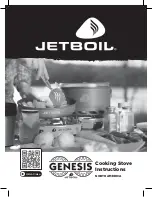
05.1 CHIMNEY COWL
A properly installed chimney cowl ensures optimum stove operation. The anti-downdraught chimney
cowl consists of a number of components whose outlet section sum always doubles the flue pipe section.
Make sure the chimney cowl is at least 150cm above the roof rise so that it is fully exposed to the wind.
The chimney cowls must:
•
have useful outlet section that is at least twice that of the flue pipe.
•
be made in such a way as to prevent the penetration of rain or snow.
•
be constructed in such a way as to ensure, in the event of winds coming from any direction, the
evacuation of combustion products.
•
be free of mechanical intake auxiliaries.
05.2 DRAUGHT
As they heat up, the gases formed during combustion undergo an increase in volume and, as a result, have a lower density than the cooler surrounding air.
This difference in temperature between the inside and outside of the flue results in a negative pressure which increases proportionally to the flue pipe length and
the temperature.
The draw of the flue pipe must be able to overcome all resistance from the fume circuit so that any smoke produced inside the stove during combustion is drawn
up and dispersed into the atmosphere through the discharge conduit and the flue pipe itself. There are many meteorological factors that influence the operation of
a flue pipe, rain, fog, snow, altitude, but the most important is the wind, which can cause negative thermal pressure as well as dynamic negative pressure.
The wind action varies depending on whether it is ascending, descending or horizontal.
•
Ascending wind always results in an increased negative pressure and draught.
•
Horizontal wind results in an increased negative pressure as long as the chimney cowl was properly installed.
•
Descending wind always diminishes the negative pressure, sometimes inverting it.
Excess draught causes an increase in the combustion temperature and consequently a loss in stove efficiency.
Some of the combustion gases, as well as small particles of combustible material, are drawn into the flue pipe before being burned,
reducing the stove's efficiency and increasing the consumption of pellets and causing the emission of polluting smoke.
At the same time the high fuel temperature, due to an excess amount of oxygen, wears down the combustion chamber sooner
than expected.
On the other hand, poor draught slows down combustion resulting in a decrease in the stove temperature, fume spillage inside
the room, a loss of stove efficiency and dangerous build-up in the flue pipe.
To avoid excessive draught it is advisable to use a draught regulator (see figure on the side).
Roof pitch α [°]
Horizontal width of reflux zone
measured from rise A [m]
Minimum height from roof for discharging
exhaust fumes H min =Z+0.50m
Height of reflux zone Z [m]
15
1.85
1.00
0.50
30
1.50
1.30
0.80
45
1.30
2.00
1.50
60
1.20
2.60
2.10
7










































